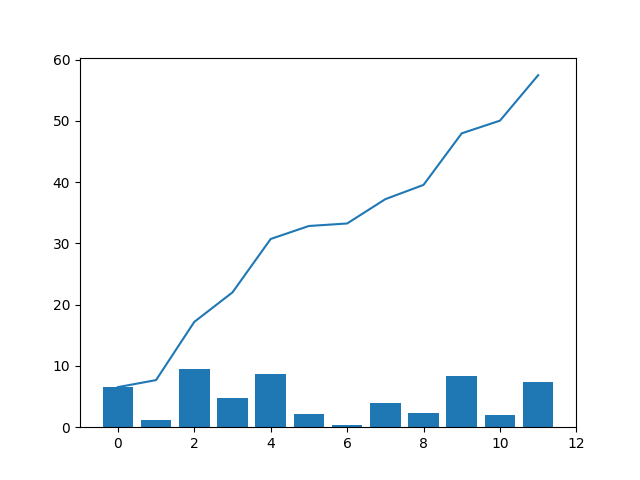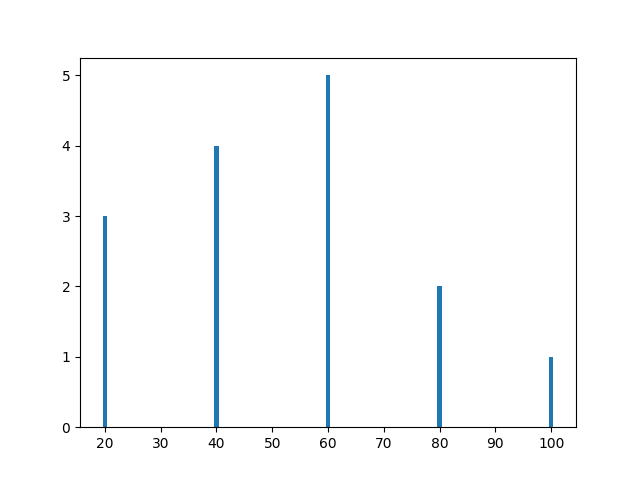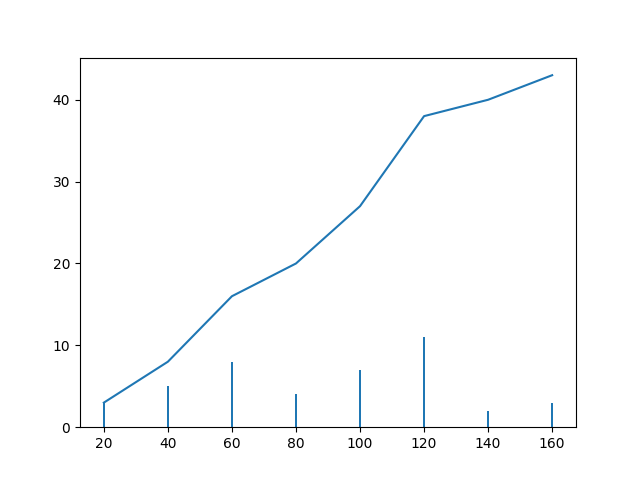numpy是一個非常有用的數值計算工具,在這個講次中我們先簡單介紹如何利用numpy函數做數據的統計分析。
陣列的內建函數
- sum:矩陣加總
- min:矩陣最小值
- max:矩陣最大值
- mean:矩陣平均值
- sum(axis=1):指定要加總的矩陣維度
- cumsum():累計加總
- random.seed():設定亂數的種子,以這個種子為開端產生的亂數序列都相同。
- np.random.random((12)):產生12個亂數的一維陣列。
- round(a,2):將a陣列中的所有浮點數四捨五入至小數點第2位
import matplotlib
matplotlib.use("Agg")
import matplotlib.pyplot as plt
import numpy as np
a = np.random.random((3, 3))
print('a=\n',a)
a1=a.sum()
a2=a.max()
a3=a.min()
a4=a.mean()
print('a.sum()=',a1)
print('a.max()=',a2)
print('a.min()=',a3)
print('a.mean()=',a4,a4*9)
b = np.arange(12).reshape(2, 6)
print('\nb=\n',b)
print('b.sum(axis=0)=',b.sum(axis=0))
print('b.sum(axis=1)=',b.sum(axis=1))
np.random.seed(1000)
revenu = np.round(np.random.random((12)) * 10., 2)
x=np.arange(0,len(revenu),1)
print('revenu=',revenu)
revcum=revenu.cumsum()
print('Cumulative Sum of revenu=\n',revcum)
plt.bar(x,revenu)
plt.plot(x,revcum)
plt.savefig("np-arr-func.png")
============輸出:=============
a=
[[0.39215413 0.18225652 0.74353941]
[0.06958208 0.8853372 0.9526444 ]
[0.93114343 0.41543095 0.02898166]]
a.sum()= 4.601069794034902
a.max()= 0.9526443992215418
a.min()= 0.02898165938687125
a.mean()= 0.5112299771149891 4.601069794034902
b=
[[ 0 1 2 3 4 5]
[ 6 7 8 9 10 11]]
b.sum(axis=0)= [ 6 8 10 12 14 16]
b.sum(axis=1)= [15 51]
revenu= [6.54 1.15 9.5 4.82 8.72 2.12 0.41 3.97 2.33 8.42 2.07 7.42]
Cumulative Sum of revenu=
[ 6.54 7.69 17.19 22.01 30.73 32.85 33.26 37.23 39.56 47.98 50.05 57.47]
一維數據的簡易統計分析
- np.mean(a):全體數據的平均值
- np.var(a):全體數據地方差
- np.std(a):全體數據的標準差
- np.median(a):全體數據的中位數
- np.average(a,weights=wts,returned=True):weights=wts,數據依照wts權重值陣列作權重平均。returned=True,回傳權重的總和。
- np.histogram(bins[1:],hist):依照bins陣列所定義的分隔,計算a陣列中在各分隔區中的數量hist。
import matplotlib
matplotlib.use("Agg")
import matplotlib.pyplot as plt
import numpy as np
a = np.array([1, 2, 3, 4])
mean_a=np.mean(a)
var_a=np.var(a)
std_a=np.std(a)
print('a=',a)
print ('np.mean(a)=',mean_a)
s=0.
for i in range(4):
s+=(a[i]-mean_a)**2
s=s/4.
print ('np.var(a)=',var_a,s)
print ('np.std(a)=',std_a,np.sqrt(s))
print('median=',np.median(a))
wts=[2.,1.,2.,1.]
print(a)
print(wts)
print('weighted average=',np.average(a,weights = wts, returned = True))
a = np.array([22,87,5,43,56,73,55,54,11,20,51,5,79,31,27])
np.histogram(a,bins = [0,20,40,60,80,100])
hist,bins = np.histogram(a,bins = [0,20,40,60,80,100])
print (hist)
print (bins[1:])
plt.bar(bins[1:],hist)
plt.savefig("np-statistics.png")
print('plot is done.')
============輸出:=============
a= [1 2 3 4]
np.mean(a)= 2.5
np.var(a)= 1.25 1.25
np.std(a)= 1.118033988749895 1.118033988749895
median= 2.5
[1 2 3 4]
[2.0, 1.0, 2.0, 1.0]
weighted average= (2.3333333333333335, 6.0)
[3 4 5 2 1]
[ 20 40 60 80 100]
plot is done.
a=np.array([[3081,3082, 3083,3084,3085, 3086,3087,3088,3089,3090,
3092,3093,3094,3096,3098,3099,3100,3101,3102,3104,3105, 3106,
3107,3108,3109,3110,3112,3113,3114,3115,3116,3117,3118,3119,
3120,3121,3122,3123,3124,3125,3126,8611,8612],[49,23,17,57,
35,35,89,102,45,107,106,59,159,74,125,127,89,85,60,114,
118,81,77,28,54,54,110,98,107,150,111,109,107,81,150,55,
58,17,32,6,75,86,107], [2,2,2,2,2,2,1,2,2,1,1,2,1,2,
2,2,2,2,2,1,1,1,1,1,1,1,1,1,1,1,1,1,1,1,1,2,1,1,
1,2,2,2,1]])
print('a=\n',a)
print(np.shape(a))


